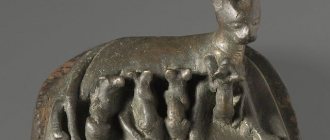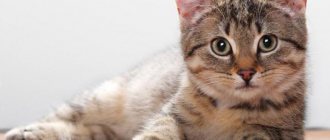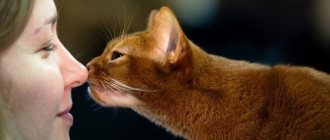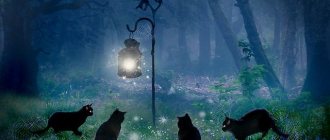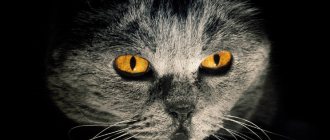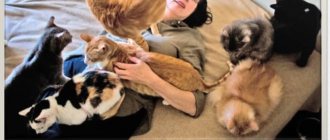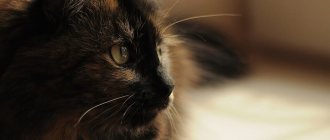Appearance of Bastet in mythology
In fact, there is very little information about the appearance of Bastet in Egyptian mythology.
It is reliably known that her father is the supreme god Ra, and her mother is the goddess Hathor. Essentially, Bastet is the daughter of the sun and the moon at the same time. Nevertheless, Buster was one of the most revered goddesses in ancient Egypt, and the popularity of her cult was not inferior to that of Amun-Ra. At least until the unification of Egypt and giving the cult of Amun-Ra the status of a state religion. Anton
Ask a Question
Question to the expert
Why are Bastet and Sekhmet considered the same character?
Before the unification of the country into a single whole, in lower Egypt people worshiped the daughter of Ra, named Bast, and in Upper Egypt they worshiped Sekhmet. However, after the unification of the country, the cult of worship merged together, and with it the images of the goddesses.
At the same time, opinions still differ even about who Bastet really was. She was believed to be the spiritual embodiment of the goddess Isis. At the same time, Bastet was responsible for many industries in Ancient Egypt. She was the goddess of joy, fun and love, the goddess of fertility. However, she was especially revered by women, because Bastet was also the goddess of the hearth, female beauty and the goddess of childbirth.
However, historians agree that Bastet gained particular popularity due to the fact that she was the goddess of cats. Perhaps no one needs to be reminded of how sacred cats were in ancient Egypt. Needless to say, if a driver who accidentally ran over a cat was stoned to death. And it was strictly forbidden to take these animals out of the country.
Cats were considered sacred animals in Egypt long before the popularization of the Bastet cult. Initially, cats were highly valued as fighters against snakes and mice. This may not be the main reason for the popularization of these animals, but it is certainly one of them.
It is not surprising that Bastet was depicted as a creature with the body of a man and the head of a cat. Moreover, she was depicted entirely in the body of a cat, but only in a sitting position. In a standing position, she remained half-human. It is noteworthy that Bast also had a second, more menacing appearance. The ancient Egyptians considered the lion a symbol of strength and protection. Therefore, it is not surprising that the second, formidable and warlike appearance of Bastet was Sekhmet - a creature with a female body and a lion’s head.
It is worth noting that Bast and Sekhmet were initially considered different characters. However, during the merger of Upper and Lower Egypt, the cult of the goddesses came together. And even before that, they were depicted in exactly the same way, with the same attributes and symbols of power, as a result of which the cult of Bastet united the goddesses into two opposing essences of one whole. In addition, during late Egypt, Bastet also merged with Isis.
Despite the fact that almost all sources say that Bast loved the color black (as evidenced by her love for black cats, as well as their demand at that time), the goddess preferred to dress in green robes. As always, in the images of that time, the goddess’s clothing was as open as possible.
The downside of cult
As you know, geese, who did not receive much attention, saved Rome, but the revered cats destroyed Egypt. They tried not to anger the goddess Bastet, who was responsible for fertility and childbirth, under any circumstances. Perhaps, fragments of old legends about her ability to turn into the merciless Sekhmet remained in the subconscious. Therefore, by the end of the existence of independent Egypt, the veneration of cats went beyond all reasonable limits.
Egypt's main opponents, the Persians, knew this very well. King Cambyses, fearing that he might be defeated in an open battle, ordered that as many cats as possible be caught and tied to shields. Such desecration of a sacred animal stunned the Egyptians. There was no question of fighting: after all, you could accidentally harm the cat squirming on the shield. The battle was lost, and Egypt became part of the Persian kingdom.
Recommended by topic
Anubis Sphinx Isis
In addition to all her areas of responsibility, Bastet was in demand and adored not only by people, but also by the gods. It was she who was part of the guard of the supreme god Ra when he sailed on his boat across the sky, and at night in the underworld. In the guise of Sekhmet, Bastet was one of those who protected Ra from the serpent Apophis, whom the sun god encountered every night in the underworld.
The attributes of the goddess were an aegis in one hand and a sistrum in the other. Bastet was often attributed to a basket (a symbol of the harvest), as well as amulets with cats (which were incredibly popular in those ancient times). This spoke completely about the character and significance of the goddess. On the one hand, Bast had an easy disposition, loved dancing, fun and celebrations, and on the other hand, she was unforgiving if it was necessary to punish someone.
Due to Bastet’s connection with the sun and moon, it was believed that she had incredibly powerful intuition, and even the gift of prediction, which was used more than once by both people and gods. And the most interesting thing is that the star Sirius was considered the symbol of the goddess, around which many secrets revolve around the pyramids and the Great Sphinx.
They say that the sound of the sistrum had amazing magical properties. He was able to heal people, give them back the meaning and purpose of life, and was able to heal both soul and body. As we said earlier, very often Bast was depicted surrounded by 4 cats, symbolizing the directions of the goddess’s work: fertility, female childbirth, patronage of marriage and motherhood.
End of the cult
Under the new government, the veneration of cats became more difficult, and the temple in Bubastis fell into disrepair. However, the cult persisted until the establishment of Roman rule. Practical Romans did not see anything special in the cat: at best, an ordinary mouse hunter. However, memories of the former heyday of the cat cult remained. Therefore, sometimes the Romans could play on the religious feelings of the Egyptians, if for some reason they did not behave too loyally. One of the Roman governors, faced with disobedience, ordered to catch all the black cats that could be found and kill them. This immediately brought the rebellious Egyptians to their senses.
Bast is a symbol of youth and beauty
Legend has it that Bast received this feature from her mother, from the goddess Hathor, who was responsible for love and beauty. However, in Ancient Egypt it was believed that it was Bast who should ask for stopping aging, rejuvenation and beauty, because she is much more friendly and kind than her mother.
Women in those days believed that if they performed a set of certain exercises, Bast would temporarily inhabit their bodies, giving them incredible health, beauty, youth and grace. However, while doing the exercises, you had to think about Bast all the time in order to summon her.
Grand Patroness
Bastet gave warmth, light and drove away evil spirits, patronized music and dance, rewarded intuition and imagination. She was believed to help childless couples create a large family .
She was prayed to by spouses who dreamed of large offspring, and by women who dreamed of preserving beauty and prolonging youth. In April, a fertility festival was celebrated, and people walked through the streets in a festive procession, chanting to Bast and praying to her for a good harvest.
The goddess also found her significance in medicine. It was customary to paint the homes of healers with black cats, which were considered a symbol of medicine.
Doctors painted the goddess near the patient’s bed so that he would recover quickly.
Read also: First aid
Bast, as Sekhmet
Help Ra
Bast did not try on her cruel appearance often. However, if this happened, then Bastet severely punished the guilty. True, she preferred to do this in the image of Sekhmet. The goddess's revenge was inexorable. Nothing could stop her, as you will learn in the next story.
A long time ago, the god Ra descended to Earth to people, taught them to live correctly and wisely. However, as always happens with people, their greed and greed exceeded all conceivable and inconceivable measures. Gradually, people began to ignore Ra’s instructions, and then they completely forgot about them, and stopped obeying the laws of the supreme god. According to another legend, people decided to overthrow Ra.
Question to the expert
Why didn’t Bastet stop the bloodshed when Ra came to his senses and ordered her to stop exterminating people?
The myths are silent about the true reason, but if we assume that Horus made a remark to the goddess about incontinence, and she accepted the reproach, then it is most logical to assume that Sekhmet was intoxicated with blood and simply could not stop.
Enraged, Ra turned to Nun for advice, who came up with nothing better than to exterminate the human race. Ra listened to the advice and sent his formidable weapon upon humanity - the Eye of Ra, which he gave to Sekhmet so that she would make the punishment a reality. The menacing incarnation of Bastet was relentless. According to legend, the weapon in her hands brought so many terrible deaths that people choked in their own blood.
It was the same Ra who stopped Sekhmet. The next day he saw the consequences of his order and took pity. However, Sekhmet was relentless. They managed to stop her only by deception, by giving her a thousand jugs of beer, painted red. The goddess mistook it for blood and became drunk, after which she fell asleep. After this, Ra left people, but that is a completely different story.
As for the goddess herself, the gods took her sleeping, and then managed to pacify her, so that she would take on her good form and change her anger to mercy. Legend has it that it took a very long time to persuade and calm the goddess.
Confronting Anubis
The second known case of the reincarnation of Bastet into Sekhmet happened because of another god - Anubis. Legend has it that one fine day they quarreled, and Anubis, possessing the head of a jackal, roared at Bast so menacingly that she was frightened, after which she became angry and turned into a lion woman. Unfortunately, the legend is silent about the end of this story, but it can be assumed that Anubis and Bastet were separated by other gods, for both deities were quite popular and approximately equal in strength.
The Legend of the Butterfly
To understand the character of Bastet, just read the following myth. Legend has it that one day Bastet was resting near a fire lit in her chambers. At that moment, a butterfly flew into her chambers and began to “play” with the fire.
This provoked the goddess, and she, in all her guises, began to chase the butterfly. However, the butterfly was cunning, or it simply liked to circle around the fire. As a result of this, Bastet was severely burned by the flames several times.
The sage god Horus came to the aid of the goddess. He refused to kill the butterfly, after which he made Bastet think about her own character. As a result, the goddess concluded that she needed to learn peace and self-control.
Appearance of a goddess
The fact that Bastet is the patroness of cats is clearly evidenced by her appearance. Archaeologists have found two types of images of this goddess. One of the portraits represents the positive side of Bastet, the other - the dark part of her nature.
Read also: How to train yourself to eat less
If we talk about the first option, Bastet appears in drawings and sculptures as a woman with the head of a cat. She was sometimes shown as a black cat adorned with jewels and sacred symbols. I think that in this case the black color is an association with night time and the moon, which Bastet also symbolized.
Sekhmet, Egyptian Goddess of War from the wall of the Temple of Kom Ombo, Egypt
If we talk about the evil nature of the goddess, then everything is not so certain. Ancient images of the goddess with the head of a lioness have survived to this day. According to legend, Bastet could take the form of a lion in a state of rage, after which she brought death, destruction and disease.
But if you are interested in Egyptian mythology, then you probably know about the goddess Sekhmet, who fits this description - half-woman, half-lioness. Of course, one deity could well transform into another, but in this case I would not equate her with the image of Bastet.
Interesting facts about Bastet
The Egyptians worshiped cats almost until the conquest, in the 4th century BC. At that time, Christianity began to be forcibly instilled in the Egyptians. As a result of this, almost all ancient deities were forgotten, including Bastet, and cats, especially black ones, began to be exterminated en masse. By the way, the belief about black cats dates back to Ancient Egypt, and many still believe in the sign.
- 7 – Exactly so many times a year holidays were held in honor of Bastet. However, the most magnificent holiday fell somewhere in mid-April. Legends and stories associated with this holiday have reached us. The same Herodotus told how women and men sailed on ships along the Nile and landed near some city.
Some sang songs, some drank wine, and some indulged in debauchery. Legend has it that many girls, when approaching cities, raised the hems of their tunics, thereby attracting men. It was believed that if a child is born on the day of the festival, he will be a demigod, because Bastet will patronize him. Over half a million people took part in such events.
- Throughout Ancient Egypt there were temples and sanctuaries dedicated to Bastet. It is noteworthy that there must have been cats and priests watching over them at this temple. It was believed that it was through cats that Bastet conveyed his orders to people.
Bubastis
As is clear from the name, this city was the center of veneration of cats and the Egyptian goddess Bastet. From the photos taken by archaeologists at the ruins of this cult center, it is clear that the cat cult reached its highest point here.
This happens in the first millennium BC, when Pharaoh Shoshenq, a Libyan by origin, moved the capital of Egypt to Bubastis. Cats clearly liked life in the capital: according to Herodotus, who personally visited the city, in the huge temple there were several thousand mustachioed and tailed cats, which were looked after by the priests with special care and immense respect. In the main hall of this feline paradise there was a one-meter high statue of Bastet.
Recommended by topic
How myths are born in mythology Mjolnir Vanaheim
- In Ancient Egypt, Bast played the role of the goddess of fertility. The common people, in order to appease the goddess, took figurines of black cats out of their houses every spring to attract the attention of the goddess so that she would bring more harvests. During the popularization of the Bast cult, a ritual was carried out at the state level in which a huge statue of a black cat was transported along the Nile so that it would protect the people from the river flood.
- One of the most developed centers of that time was the city of Heliopolis. And in it, the role of the goddess Bast was no less popular and in demand than the role of Ra himself. They erected an amazing, at that time, statue of the goddess, exposing the goddess in her guise as a half-man, half-cat. However, its peculiarity was that, depending on the angle of incidence of the sun, the pupils of the statue either expanded or contracted, just like those of a real animal.
- Cats in Ancient Egypt were such popular animals that when a pet died, the owners shaved off their eyebrows as a sign of mourning, and the animal itself was mummified and buried with honors that not every person received.
- The fashion for the famous arrows under the eyes of women has started since the times of Ancient Egypt. It was believed that in this way women emphasize their resemblance to the goddess.
- Bastet is one of the few goddesses to whom a separate city was dedicated - Bubastis. In it, the significance of the cult reached unprecedented heights, as did the level of cat worship. And it’s not surprising, because Bubastis was one of the key cities of Ancient Egypt.
- The significance of cats in Ancient Egypt was not only cult. Cats saved crop supplies from pests (rodents and snakes). Perhaps this is one of the reasons why the animal has become more than sacred.
As you can see, Bast was one of the most revered and significant goddesses in Ancient Egypt. Considering the areas for which she was responsible, this is not at all surprising. However, its history, although open, also raises many questions, as with everything related to Egypt.
Origin
From ancient Egyptian myths it follows that Bastet's father was the sun god Ra. However, there are other versions. For example, in some regions it was believed that Bastet was the daughter of Osiris and Isis. This is apparently due to the fact that the development of Egyptian theology followed the path of replacing one deity with another. So Osiris, originally the god of fertility, eventually became the judge of the underworld, and it was this function that Ra once performed. At one time, Bastet’s husband was considered to be the dwarf Bes, the joy-giving patron of the elderly and children.
It should be noted that sometimes another version of the name of this Egyptian goddess is found in literature. Bastet is an artificially created name because the exact pronunciation of Egyptian hieroglyphs is not known. Since the vowels were not shown on the letter, the pronunciation of the name could appear as "Bast". Both options are equal.
